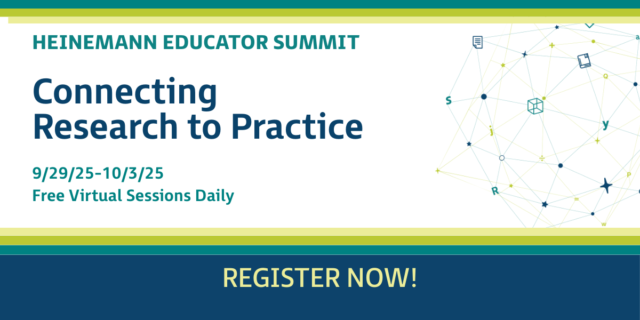
Heinemann Community:
Over the past two years, we’ve talked broadly about Heinemann’s vision for the future – a strategy that is focused around strengthening and diversifying our resources, modernizing our approach to professional learning and accelerating our digital transformation. While each pillar of that strategy continues to drive meaningful change at Heinemann, there’s been heightened discussion recently about the appropriate use of digital tools in the classroom. Today, I’d like to focus on Heinemann’s approach to technology and how we’re thinking of new tools and resources as a thoughtful way to enhance classroom instruction.
When you think of an inquiry-based approach to instruction, many people think of children sitting on a colorful rug on the floor reading books or engaging with an animated teacher able to give one-on-one attention to each of her students. This picture feels tangible, even nostalgic, and often doesn’t include the use of screens or other technology. During the COVID-19 pandemic, digital technology and edtech tools became a necessary way to deliver remote or hybrid instruction. As we have emerged from that time back to in-person schooling, technology has become more of a mainstay in American classrooms and a symbol of a changing, more digitally connected world. Appropriately, we’ve seen an ongoing debate emerge about how best to responsibly and ethically integrate these tools in a meaningful way to help move students forward.
At Heinemann, child-centered, inquiry-based pedagogy has driven the way we and our authors have approached instruction for more than 40 years and will continue to shape our resources as we move forward. And we are also excited about the ways that digital technology can be thoughtfully and intentionally incorporated to enhance the inquiry process and help foster and drive an active learning environment, while also preparing students to live in an increasingly digital world. As we think about the future of technology in the classroom, we are committed to designing responsible and developmentally appropriate blended solutions that have the power to drive student engagement and to increase the kind of responsive, differentiated instruction that is central to inquiry-based learning.

Supporting the Teacher
There is extensive research that shows that a teacher is the single greatest indicator of student success. That’s why Heinemann’s mission has always been centered around teachers, helping them access the tools, resources and expertise to serve the students in front of them. One of the most exciting ways technology can really benefit educators and students is by providing tools that save teachers time so they can focus on engaging with their students and differentiating instruction to help move each individual learner forward.
This summer, Heinemann released a new edition of our Writing Units of Study for Grades 3-5 that incorporates a truly innovative digital experience designed to help teachers more easily provide responsive instruction. The new Units harness the power of AI as a tool for educators by giving teachers access to generative AI-suggested comments, uniquely tuned to the instruction and style of Units of Study, to provide each student with customized feedback. This feature helps teachers more quickly and easily see patterns in students' writing and identify areas of support, extending teacher capacity and deepening student engagement and success.
Driving Student Engagement
We know that student engagement and motivation are key ingredients in helping to drive academic success and create students who will become lifelong learners.
Last year, Heinemann announced the launch of game-based math solution Matific for US schools. This research-based program is designed for students in K-6 and features math lessons and activities delivered through a game-based application with a focus on making math engaging, interactive and fun for students. All activities are standards-aligned and developed in partnership with leading researchers from institutions like Berkely, Harvard, Stanford and the Einstein Institute to ensure that Matific’s math activities line up with the most up-to-date research in education and child development.
This kind of game-based resource provides an authentic and modern way to engage students in the learning process, using tools that are increasingly familiar to them in an increasingly digital world.
Intentional, Responsible and Developmentally Appropriate
Recently, there’s been increased conversation around the appropriate use of technology in classrooms and we’ve heard concerns ranging from how we responsibly introduce generative AI to how we navigate student use of screens, especially in K-2 classrooms. These are important questions and ones we take seriously as an organization dedicated to teachers and students. Our recent work has shown us that there is great promise in what we can achieve if we are responsible and intentional in how we integrate these tools, making sure that we are using research to inform decisions and engaging with thought leaders to ask the right questions.
This summer, we launched a blog series and podcast with two teachers at Exeter High School in New Hampshire, Dr. Dennis Magliozzi and Kristina Peterson, who are using ChatGPT in their classrooms as a means of extending students’ critical thinking within a writing workshop. The series focuses on the impact of generative AI in the classroom and thinks through important questions about how we can ethically harness this technology to enhance student learning. The duo will release a professional book on the topic in 2025.
We’re also focused on making sure that students have the support they need to become digitally literate as they come of age in a technology-driven culture. We’ll publish a book this fall by author Marilyn Pryle called 5 Questions for Any Text: Critical Reading in the Age of Disinformation. This professional book will give teachers an important framework to help students learn to evaluate the trustworthiness of online, audio, video and print content.
Lastly, it’s important to recognize that the print vs. digital conversation is nuanced and one that we will continue to follow as it evolves to make sure that we are designing solutions that will be effective for both teachers and students. For example, recent studies have found that learning to read via print books may have some benefit in building students’ comprehension skills, but have also pointed to some interesting ways that the design of digital books can help to enhance comprehension as well.
At Heinemann, we value the opportunity for students to engage with many different types of authentic text across the day as they are learning to read and for teachers to have the tools to respond to each student’s individual needs. Our literacy resources include both digital and printed student books, ensuring that educators have the options they need to maximize learning.
As we continue to work towards accelerating our digital transformation, I’m proud of what we’ve accomplished in these last two years and excited about where we’re headed. Embracing new technologies can help us to enhance and extend inquiry-based learning and allow teachers more time to do what they do best – engage with students and help unlock their learning potential.
Thank you,
Maggie DeMont


